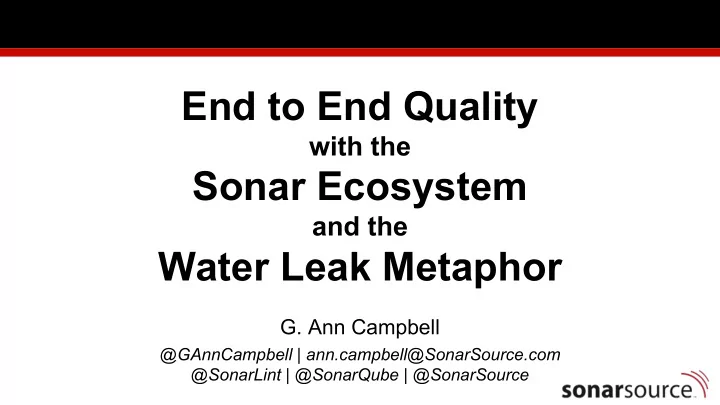

End to End Quality with the Sonar Ecosystem and the Water Leak Metaphor G. Ann Campbell @GAnnCampbell | ann.campbell@SonarSource.com @SonarLint | @SonarQube | @SonarSource
SonarLint Leak Period Quality Gate
20+ Languages
The <3 of the ecosystem Static Analysis
What is Static Analysis? Analyzing code, without executing it!
A Means to an End Detecting Bugs, Vulnerabilities, and Code Smells
Why use Static Analysis Catch new problems ASAP ● the longer it takes to catch a bug, the more it costs ● no one writes perfect code every time ● rule description and precise issue location cut research time
Why use Static Analysis Changing A might have added bugs in B ● peer review misses new issues in untouched code ● static analysis is machine-assisted code review; it looks at every file every time
Why use Static Analysis Provide coaching ● language best practices ● team coding style
SonarSource’s Toolbox
Lexical Analysis Only two things are infinite, the universe and human stupidity, and I am not sure about the former.
Syntactic Analysis Only two things are infinite, the universe and human stupidity, and I am not sure about the former. Subjects Verbs Albert E.
Semantic Analysis Only two things are infinite, the universe and human stupidity, and I am not sure about the former. Albert E.
Semantic Analysis Only two things are infinite, the universe and human stupidity, and I am not sure about the former. Albert E.
Beyond Semantic: Symbolic Execution Object myObject = new Object(); if(a) { myObject = null; } ... if( !a ) { ... } else { myObject.toString(); }
Beyond Semantic: Symbolic Execution Object myObject = new Object(); if(a) { myObject = null; } ... if( !a ) { ... } else { myObject.toString(); } //NPE
Beyond Semantic: Symbolic Execution Object myObject = new Object(); Program State#0 myObject != null if(a) { myObject = null; } ... if( !a ) { ... } else { myObject.toString(); } //NPE
Beyond Semantic: Symbolic Execution Object myObject = new Object(); Program State#0 myObject != null Program State#2 myObject = null a = true if(a) { myObject = null; } Program State#1 ... myObject != null a = false if( !a ) { ... } else { myObject.toString(); } //NPE
Beyond Semantic: Symbolic Execution Program State#1 Program State#2 myObject != null myObject = null a = false a = true ... if( !a ) { ... } else { myObject.toString(); // NPE }
Beyond Semantic: Symbolic Execution Program State#1 Program State#2 myObject != null myObject = null a = false a = true ... if( !a ) { ... } else { myObject.toString(); // NPE }
Beyond Semantic: Symbolic Execution Program State#1 Program State#2 myObject != null myObject = null a = false a = true ... if( !a ) { ... } else { Program State#4 myObject = null a = true myObject.toString(); // NPE }
SonarAnalyzer for Java and JavaScript Cross-Procedural Analysis
What is Static Analysis ? Analyzing code, without executing it. by (symbolically) executing all possible paths!
Symbolic Execution Almost Everywhere ▪ SonarAnalyzers for C#, C/C++, Java, and JS ○ Dereferences of Null Pointers ○ Unconditionally True/False (sub)conditions ○ Division by zero ○ Resource leaks ■ Unclosed resources (Java) ■ Unreleased memory (C/C++) ○ Double free (C/C++)
Fewer slides, more code!
Full Cycle Full Analysis IDE SonarQube
Full Cycle IDE SonarQube
Fix the Leak SonarLint Leak Period Quality Gate
Reimbursing the Debt
This is Hard ▪ Total amount of Technical Debt can be depressing ▪ How to get a budget to fix old Technical Debt? ▪ Risk of injecting functional regression ▪ This is not fun!
Project Homepage
Project Homepage: Leak Period
Fix the Leak SonarLint Leak Period Quality Gate
Quality Gate
Project Homepage: Quality Gate
Quality Gate
Fix the Leak SonarLint Leak Period Quality Gate
Thanks! G. Ann Campbell @GAnnCampbell | ann.campbell@SonarSource.com @SonarLint | @SonarQube | @SonarSource
Recommend
More recommend